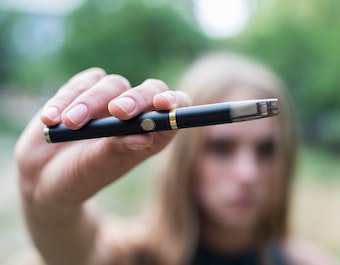Lured by flavors
When it comes to why teens themselves say they vape, many of their reasons have a social connection. In the 2019 National Youth Tobacco Survey, middle and high school students named their top reasons for trying e-cigarettes as:
- Curiosity (55.3%)
- A friend or family member used them (30.8%)
- Availability of flavors like mint, candy, fruit, or chocolate (22.4%)
- They can be used to do tricks (21.2%)
“They see a friend or family member vaping, and they want to try it,” Richter says. “They like to do the vaping tricks, like making big clouds, and they really, really like the flavors.”
When most teens try an e-cigarette for the first time, it’s one with flavoring, according to the CDC, and teens who use e-cigarettes with flavored liquid vape longer, too.
The FDA recently announced that it was banning the sale of all flavors, except menthol and tobacco, in prepackaged pods and cartridges used in rechargeable devices. In response, some top brands have stopped selling fruit, candy, and mint flavors. There is some worry, though, that if menthol is still in the mix, teens will simply make the switch. In 2019, 57.3% of high school students who vaped used mint or menthol e-cigarettes.
There are also some very large loopholes in the flavor ban. Disposable e-cigarettes can still be sold in flavors like fruit or candy. Vape shops can also still sell flavored e-liquids for refillable devices. Physical retail stores, including vape shops, are where 74% of young people buy e-cigarettes, according to a 2018 survey by the Truth Initiative.
The loophole has led to the rise in popularity among flavored disposable e-cigarettes that come pre-charged and pre-filled, according to the Truth Initiative. Most of these disposable e-cigarettes are cheaper than non-disposable devices and contain as much nicotine as some popular pods.
The draw of devices The change in the way e-cigarettes look has also made it easier for teens to vape more often. “E-cigarettes look cool, they look like tech devices, and they’re easy to hide,” Richter says.
Between 2017 and 2018, e-cigarette use surged among high school students by 78%. The CDC says this “is likely because of the recent popularity of e-cigarettes shaped like a USB flash drive. These products can be used discreetly, have a high nicotine content, and come in flavors that appeal to youths.”
Some e-cigarettes also now produce less aerosol and very little scent, making them much easier to use indoors without being detected, Thompson says. “People can take a puff or two, and put it right back in their pocket,” she says.
And the more kids who vape, the more it becomes a normal part of a teen’s experience, increasing the likelihood of more kids who will try vaping, Richter says.
“When you ask kids how many kids are vaping in their school, they say, ‘Everyone,’” she says. “The numbers are high, but it’s not everyone, it’s still a minority. But kids’ perception of how common something is is a subtle form of peer pressure.”





